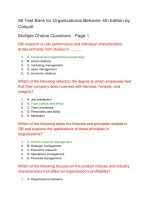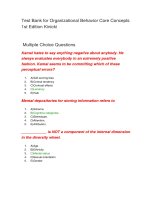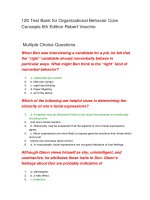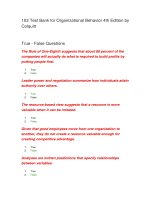Organizational behavior core concepts by kinicki chapter12
Bạn đang xem bản rút gọn của tài liệu. Xem và tải ngay bản đầy đủ của tài liệu tại đây (318.91 KB, 36 trang )
12
Organizational Behavior
core concepts
Organizational Culture: How
Organization’s Create and
Transmit a Culture
12-2
McGraw-Hill/Irwin
Organizational Behavior, Core Concepts
Copyright © 2008 by the McGraw-Hill Companies, Inc. All rights reserved.
Learning Objectives
12-3
• Discuss the layers and functions of
organizational culture.
• Define the general types of organizational
culture and identify their associated normative
beliefs.
• Explain how organizations embed their
cultures.
• Summarize the process of organizational
socialization in terms of three phases.
• Describe methods for socializing employees.
• Discuss the role of mentors in organizations.
Organizational Culture
• Organizational culture
– set of shared, taken-for-granted implicit
assumptions that a group holds and that
determines how it perceives, thinks about,
and reacts to its various environments
12-4
Organizational Culture
• Shaped by four components:
– Founder’s values
– Industry and business environment
– National culture
– Senior leaders vision
12-5
Layers of Organizational Culture
• Observable artifacts
– Consist of the physical manifestation of an
organization’s culture
– Acronyms, manner of dress, awards, myths
and stories, published lists of values,
observable rituals and ceremonies, special
parking spaces, and decorations
12-6
Layers of Organizational Culture
• Values
– concepts or beliefs that pertain to desirable
end states, transcend situations, guide
selection of behavior and are ordered by
relative importance
• Espoused values
– represent the explicitly stated values and
norms that are preferred by an organization
12-7
Question?
What represents the values and norms that
actually are exhibited or converted into
employee behavior?
A. Espoused values
B. Valued behavior
C. Enacted values
D. Basic assumptions
12-8
Layers of Organizational Culture
• Enacted values
– represent the values and norms that actually
are exhibited or converted into employee
behavior
– Based on
observable behavior
12-9
Layers of Organizational Culture
• Basic assumptions
– Constitute organizational values that have
become so taken for granted over time that
they become assumptions that guide
organizational behavior
12-10
Functions of Organizational
Culture
1. Give members an organizational
identity
2. Facilitate collective commitment
3. Promote social system stability
4. Shape behavior by helping members
make sense of their surroundings
12-11
Figure 2-2
Types of Organizational Culture
• Constructive
• Passive-defensive
• Aggressive-defensive
12-12
Organizational Culture
• Normative beliefs
– thoughts and beliefs about expected
behavior and
modes of conduct
12-13
Types of Organizational Culture
• Constructive
– Employees are encouraged to interact with
others and to work on tasks and projects in
ways that will assist them in satisfying their
need to grow and develop
– Associated with achievement, selfactualizing, humanistic-encouraging, and
affiliative
12-14
Types of Organizational Culture
• Passive-defensive
– Overriding belief that employees must
interact with others in ways that do not
threaten their own job security
– Associated with approval, conventional,
dependent, and avoidance
12-15
Types of Organizational Culture
• Aggressive-defensive
– Encourages employees to approach tasks in
forceful ways in order to protect their status
and job security
– Associated with oppositional power,
competitive, and perfectionistic
12-16
Outcomes Associated with
Organizational Culture
1. Significantly correlated with employee
behavior and attitudes
2. Congruence between an individual’s values
and the organization’s values was associated
with organizational commitment, job
satisfaction, intention to quit, and turnover
3. Did not predict financial performance
4. Mergers frequently failed due to incompatible
cultures
12-17
Embedding Organizational Culture
• Organizational members teach each
other about the organization’s preferred
values, beliefs, expectations, and
behaviors
12-18
Embedding Organizational Culture
• Formal statements of organizational
philosophy, mission, vision, values, and
materials used for recruiting, selection
and socialization
• The design of physical space, work
environments, and buildings
• Slogans, language, acronyms, and
sayings
12-19
Embedding Organizational Culture
• Deliberate role modeling, training
programs, teaching and coaching by
managers and supervisors
• Explicit rewards, status symbols, (e.g.,
titles) and promotion criteria
• Stories, legends, and myths about key
people and events
12-20
Embedding Organizational Culture
• The organizational activities, processes,
or outcomes that leaders pay attention to,
measure, and control
• Leader reactions to critical incidents and
organizational crises
• The workflow and organizational
structure
12-21
Embedding Organizational Culture
• Organizational systems and procedures
• Organizational goals and the associated
criteria used for recruitment, selection,
development, promotion, layoffs, and
retirement of people
12-22
Organizational Socialization
• Organizational Socialization
– process by which a person learns the
values, norms, and required behaviors which
permit him to participate as a member of the
organization
12-23
Phase 1: Anticipatory Socialization
• Occurs before an individual joins an
organization
• Involves the information people learn
about different careers, occupations,
professions, and organizations
12-24
Phase 2: Encounter
• Employees learn what the organization is
really like and reconcile unmet
expectations
• Onboarding
– programs aimed at helping employees
integrate, assimilate, and transition to new
jobs
12-25









